Improving Lignocellulosic and Non-Lignocellulosic Biomass Characteristics through Torrefaction Process
Abstract
1. Introduction
Literature Review
2. Experimental Part
2.1. Biomass Feedstock and Sample Preparation
2.2. Torrefaction Process of the Raw Biomass
2.3. Analytical Methods
3. Results
3.1. Properties of Raw Biomass Samples
3.2. Torrefaction Performance and Severity Index
3.3. TGA and DTG Analysis
3.4. FTIR Analysis
4. Conclusions
Author Contributions
Funding
Institutional Review Board Statement
Informed Consent Statement
Data Availability Statement
Conflicts of Interest
Abbreviations
| AC | Ash content |
| DTG | Derivative thermogravimetric analysis |
| EF | Enhancement factor |
| EMCI | Energy–mass co-benefit index |
| EY | Energy yield |
| FC | Fixed carbon |
| FTIR | Fourier transform infrared spectroscopy |
| H | Hops |
| HHV | Higher heating value (MJ/kg) |
| M | Miscanthus |
| MY | Mass yield |
| RES | Renewable energy sources |
| SF | Severity factor |
| SS | Sewage sludge |
| VM | Volatile matter |
| TGA | Thermogravimetric analysis |
| T | Temperature |
| t | time |
| TS | Torrefaction severity |
| TSI | Torrefaction severity index |
| WL | Weight loss |
References
- Portal Energetika, MZI. 2022. Available online: https://www.energetika-portal.si/nc/novica/n/informacija-glede-izredne-rasti-cen-energentov-na-energetskih-trgih-4612/ (accessed on 5 September 2022).
- Trejo, A.; Martín, M.J.; Gómez-Quintana, A.; Cava, R.; García-Parra, J.J.; Ramírez, M.R. Effect of slicing of top quality (Montanera) Iberian dry-cured chorizo on the stability to high pressure treatment and storage. J. Food Sci. 2021, 86, 1963–1978. [Google Scholar] [CrossRef]
- Kota, K.B.; Shenbagaraj, S.; Sharma, P.K.; Sharma, A.K.; Ghodke, P.K.; Chen, W.-H. Biomass torrefaction: An overview of process and technology assessment based on global readiness level. Fuel 2022, 324, 124663. [Google Scholar] [CrossRef]
- Petrovič, A.; Vohl, S.; Predikaka, T.C.; Bedoić, R.; Simonič, M.; Ban, I.; Čuček, L. Pyrolysis of Solid Digestate from Sewage Sludge and Lignocellulosic Biomass: Kinetic and Thermodynamic Analysis, Characterization of Biochar. Sustainability 2021, 13, 9642. [Google Scholar] [CrossRef]
- SURS. SURS, OVE. 2020. Available online: https://pxweb.stat.si/SiStatData/pxweb/sl/Data/Data/1815406S.px/table/tableViewLayout2/ (accessed on 5 September 2022).
- Vlada Republike Slovenije. Nacionalni Energetsko Podnebni Načrt Slovenije. 2020, p. 233. Available online: https://www.energetika-portal.si/dokumenti/strateski-razvojni-dokumenti/nacionalni-energetski-in-podnebni-nacrt/ (accessed on 5 September 2022).
- Gajera, B.; Tyagi, U.; Sarma, A.K.; Jha, M.K. A Study of Impact of Torrefaction on Thermal Behavior of Wheat Straw and Groundnut Stalk Biomass from Punjab, India: Kinetic and Thermodynamic Approach. SSRN Electron. J. 2022, 12, 100073. [Google Scholar] [CrossRef]
- Amalina, F.; Razak, A.S.A.; Krishnan, S.; Zularisam, A.; Nasrullah, M. A comprehensive assessment of the method for producing biochar, its characterization, stability, and potential applications in regenerative economic sustainability—A review. Clean. Mater. 2022, 3, 100045. [Google Scholar] [CrossRef]
- Saravanan, A.; Kumar, P.S.; Jeevanantham, S.; Karishma, S.; Dai-Viet, N.V. Recent advances and sustainable development of biofuels production from lignocellulosic biomass. Bioresour. Technol. 2022, 344, 126203. [Google Scholar] [CrossRef]
- Panoutsou, C.; Giarola, S.; Ibrahim, D.; Verzandvoort, S.; Elbersen, B.; Sandford, C.; Malins, C.; Politi, M.; Vourliotakis, G.; Zita, V.E.; et al. Opportunities for Low Indirect Land Use Biomass for Biofuels in Europe. Appl. Sci. 2022, 12, 4623. [Google Scholar] [CrossRef]
- Zhang, Z.; Duan, H.; Zhang, Y.; Guo, X.; Yu, X.; Zhang, X.; Rahman, M.; Cai, J. Investigation of kinetic compensation effect in lignocellulosic biomass torrefaction: Kinetic and thermodynamic analyses. Energy 2020, 207, 118290. [Google Scholar] [CrossRef]
- Cardarelli, A.; Pinzi, S.; Barbanera, M. Effect of torrefaction temperature on spent coffee grounds thermal behaviour and kinetics. Renew. Energy 2022, 185, 704–716. [Google Scholar] [CrossRef]
- Barskov, S.; Zappi, M.; Buchireddy, P.; Dufreche, S.; Guillory, J.; Gang, D.; Hernandez, R.; Bajpai, R.; Baudier, J.; Cooper, R.; et al. Torrefaction of biomass: A review of production methods for biocoal from cultured and waste lignocellulosic feedstocks. Renew. Energy 2019, 142, 624–642. [Google Scholar] [CrossRef]
- Chen, W.-H.; Cheng, C.-L.; Show, P.-L.; Ong, H.C. Torrefaction performance prediction approached by torrefaction severity factor. Fuel 2019, 251, 126–135. [Google Scholar] [CrossRef]
- Saikia, N.; Bardalai, M. Thermal Analysis and Kinetic Parameters Determination of Biomass Using Differential Thermal Gravimetric Analysis in N 2 Atmosphere. Mater. Today Proc. 2018, 5, 2146–2156. [Google Scholar] [CrossRef]
- Oluoti, K.; Doddapaneni, T.R.K.; Richards, T. Investigating the kinetics and biofuel properties of Alstonia congensis and Ceiba pentandra via torrefaction. Energy 2018, 150, 134–141. [Google Scholar] [CrossRef]
- Jouhara, H.; Czajczynska, D.; Ghazal, H.; Krzyżyńska, R.; Anguilano, L.; Reynolds, A.; Spencer, N. Municipal waste management systems for domestic use. Energy 2017, 139, 485–506. [Google Scholar] [CrossRef]
- Singh, K.; Zondlo, J. Characterization of fuel properties for coal and torrefied biomass mixtures. J. Energy Inst. 2017, 90, 505–512. [Google Scholar] [CrossRef]
- Nepal, R.; Kim, H.J.; Poudel, J.; Oh, S.C. A study on torrefaction of spent coffee ground to improve its fuel properties. Fuel 2022, 318, 123643. [Google Scholar] [CrossRef]
- Hibino, T.; Kobayashi, K.; Hitomi, T. Biomass solid oxide fuel cell using solid weed waste as fuel. Electrochim. Acta 2021, 388, 138681. [Google Scholar] [CrossRef]
- Arenas, C.N.; Navarro, M.V.; Martínez, J.D. Pyrolysis kinetics of biomass wastes using isoconversional methods and the distributed activation energy model. Bioresour. Technol. 2019, 288, 121485. [Google Scholar] [CrossRef]
- Abdulyekeen, K.A.; Umar, A.A.; Patah, M.F.A.; Daud, W.M.A.W. Torrefaction of biomass: Production of enhanced solid biofuel from municipal solid waste and other types of biomass. Renew. Sustain. Energy Rev. 2021, 150, 111436. [Google Scholar] [CrossRef]
- Nwabunwanne, N.; Vuyokazi, T.; Olagoke, A.; Mike, O.; Patrick, M.; Anthony, O. Torrefaction Characteristics of Blended Ratio of Sewage Sludge and Sugarcane Bagasse for Energy Production. Appl. Sci. 2021, 11, 2654. [Google Scholar] [CrossRef]
- Yogalakshmi, K.N.; Poornima, D.T.; Sivashanmugam, P.; Kavitha, S.; Yukesh, K.R.; Varjani, S.; AdishKumar, S.; Kumar, G.; Rajesh, B.J. Lignocellulosic biomass-based pyrolysis: A comprehensive review. Chemosphere 2022, 286, 131824. [Google Scholar] [CrossRef]
- Akbarian, A.; Andooz, A.; Kowsari, E.; Ramakrishna, S.; Asgari, S.; Cheshmeh, Z.A. Challenges and opportunities of lignocellulosic biomass gasification in the path of circular bioeconomy. Bioresour. Technol. 2022, 362, 127774. [Google Scholar] [CrossRef] [PubMed]
- Carota, E.; Crognale, S.; Russo, C.; Petruccioli, M.; D’Annibale, A. Lignocellulolytic Potential of the Recently Described Species Aspergillus olivimuriae on Different Solid Wastes. Appl. Sci. 2021, 11, 5349. [Google Scholar] [CrossRef]
- Li, W.; Ciais, P.; Makowski, D.; Peng, S. A global yield dataset for major lignocellulosic bioenergy crops based on field measurements. Sci. Data 2018, 5, 180169. [Google Scholar] [CrossRef] [PubMed]
- Global Bioenergy Statistics 2021. Available online: https://www.worldbioenergy.org/news/640/47/Global-Bioenergy-Statistics-2021/ (accessed on 5 September 2022).
- Trajnostna Energija, Lesna Biomasa. 2022. Available online: http://www.trajnostnaenergija.si/Trajnostna-energija/Ohranite-okolje-čisto/Lesna-biomasa/Lesna-biomasa-v-Sloveniji (accessed on 5 September 2022).
- Shaddel, S.; Bakhtiary-Davijany, H.; Kabbe, C.; Dadgar, F.; Østerhus, S. Sustainable Sewage Sludge Management: From Current Practices to Emerging Nutrient Recovery Technologies. Sustainability 2019, 11, 3435. [Google Scholar] [CrossRef]
- Jayaraman, K.; Gökalp, I. Pyrolysis, combustion and gasification characteristics of miscanthus and sewage sludge. Energy Convers. Manag. 2015, 89, 83–91. [Google Scholar] [CrossRef]
- Nguyen, Q.; Nguyen, D.D.; Vothi, H.; He, C.; Goodarzi, M.; Bach, Q.-V. Isothermal torrefaction kinetics for sewage sludge pretreatment. Fuel 2020, 277, 118103. [Google Scholar] [CrossRef]
- Huang, Y.; Chen, M.; Luo, H. Nonisothermal torrefaction kinetics of sewage sludge using the simplified distributed activation energy model. Chem. Eng. J. 2016, 298, 154–161. [Google Scholar] [CrossRef]
- Chen, G.-B.; Chatelier, S.; Lin, H.-T.; Wu, F.-H.; Lin, T.-H. A Study of Sewage Sludge Co-Combustion with Australian Black Coal and Shiitake Substrate. Energies 2018, 11, 3436. [Google Scholar] [CrossRef]
- Białowiec, A.; Pulka, J.; Styczyńska, M.; Koziel, J.A.; Kalka, J.; Jureczko, M.; Felis, E.; Manczarski, P. Is Biochar from the Torrefaction of Sewage Sludge Hazardous Waste? Materials 2020, 13, 3544. [Google Scholar] [CrossRef]
- Fan, Y.; Hornung, U.; Dahmen, N. Hydrothermal liquefaction of sewage sludge for biofuel application: A review on fundamentals, current challenges and strategies. Biomass Bioenergy 2022, 165, 106570. [Google Scholar] [CrossRef]
- Raksasat, R.; Abdelfattah, E.A.; Liew, C.S.; Rawindran, H.; Kiatkittipong, K.; Mohamad, M.; Zaid, H.F.M.; Jumbri, K.; Lam, M.K.; Lim, J.W. Enriched sewage sludge from anaerobic pre-treatment in spurring valorization potential of black soldier fly larvae. Environ. Res. 2022, 212, 113447. [Google Scholar] [CrossRef]
- Hušek, M.; Moško, J.; Pohořelý, M. Sewage sludge treatment methods and P-recovery possibilities: Current state-of-the-art. J. Environ. Manag. 2022, 315, 115090. [Google Scholar] [CrossRef]
- Chen, W.-H.; Aniza, R.; Arpia, A.A.; Lo, H.-J.; Hoang, A.T.; Goodarzi, V.; Gao, J. A comparative analysis of biomass torrefaction severity index prediction from machine learning. Appl. Energy 2022, 324, 119689. [Google Scholar] [CrossRef]
- Simonic, M.; Goricanec, D.; Urbancl, D. Impact of torrefaction on biomass properties depending on temperature and operation time. Sci. Total. Environ. 2020, 740, 140086. [Google Scholar] [CrossRef]
- Gao, N.; Kamran, K.; Quan, C.; Williams, P.T. Thermochemical conversion of sewage sludge: A critical review. Prog. Energy Combust. Sci. 2020, 79, 100843. [Google Scholar] [CrossRef]
- Naqvi, S.R.; Tariq, R.; Shahbaz, M.; Naqvi, M.; Aslam, M.; Khan, Z.; Mackey, H.; Mckay, G.; Al-Ansari, T. Recent developments on sewage sludge pyrolysis and its kinetics: Resources recovery, thermogravimetric platforms, and innovative prospects. Comput. Chem. Eng. 2021, 150, 107325. [Google Scholar] [CrossRef]
- Selamawit, M.; Agizew, N. Bio methane potential of sludge from municipal sewer and exchange stations. Heliyon 2022, 8, e08732. [Google Scholar] [CrossRef]
- Urban Waste Water Treatment Directive (UWWTD) (91/271/CEE). 2022. Available online: https://ec.europa.eu/environment/water/water-urbanwaste/legislation/directive_en.htm (accessed on 5 September 2022).
- Ribeiro, J.M.C.; Godina, R.; Matias, J.C.d.O.; Nunes, L.J.R. Future Perspectives of Biomass Torrefaction: Review of the Current State-Of-The-Art and Research Development. Sustainability 2018, 10, 2323. [Google Scholar] [CrossRef]
- Chen, W.-H.; Lin, B.-J.; Lin, Y.-Y.; Chu, Y.-S.; Ubando, A.T.; Show, P.L.; Ong, H.C.; Chang, J.-S.; Ho, S.-H.; Culaba, A.B.; et al. Progress in biomass torrefaction: Principles, applications and challenges. Prog. Energy Combust. Sci. 2020, 82, 100887. [Google Scholar] [CrossRef]
- Zhang, C.; Ho, S.-H.; Chen, W.-H.; Xie, Y.; Liu, Z.; Chang, J.-S. Torrefaction performance and energy usage of biomass wastes and their correlations with torrefaction severity index. Appl. Energy 2018, 220, 598–604. [Google Scholar] [CrossRef]
- Chang, S.S.; Sambeth, S.K.; Samad, N.A.F.A.; Saleh, S. Effect of torrefaction on thermal degradation and functional group of oil palm solid waste. Mater. Today Proc. 2022, 57, 1248–1255. [Google Scholar] [CrossRef]
- Xin, S.; Mi, T.; Liu, X.; Huang, F. Effect of torrefaction on the pyrolysis characteristics of high moisture herbaceous residues. Energy 2018, 152, 586–593. [Google Scholar] [CrossRef]
- Álvarez, A.; Nogueiro, D.; Pizarro, C.; Matos, M.; Bueno, J.L. Non-oxidative torrefaction of biomass to enhance its fuel properties. Energy 2018, 158, 1–8. [Google Scholar] [CrossRef]
- Chen, W.-H.; Lin, B.-J.; Colin, B.; Chang, J.-S.; Pétrissans, A.; Bi, X.; Pétrissans, M. Hygroscopic transformation of woody biomass torrefaction for carbon storage. Appl. Energy 2018, 231, 768–776. [Google Scholar] [CrossRef]
- Ivanovski, M.; Goricanec, D.; Krope, J.; Urbancl, D. Torrefaction pretreatment of lignocellulosic biomass for sustainable solid biofuel production. Energy 2021, 240, 122483. [Google Scholar] [CrossRef]
- Dyjakon, A.; Noszczyk, T. Alternative Fuels from Forestry Biomass Residue: Torrefaction Process of Horse Chestnuts, Oak Acorns, and Spruce Cones. Energies 2020, 13, 2468. [Google Scholar] [CrossRef]
- Zhang, C.; Yang, W.; Chen, W.-H.; Ho, S.-H.; Pétrissans, A.; Pétrissans, M. Effect of torrefaction on the structure and reactivity of rice straw as well as life cycle assessment of torrefaction process. Energy 2021, 240, 122470. [Google Scholar] [CrossRef]
- Pedroso, D.; Machin, E.; Cabrera-Barjas, G.; Flores, M.; Urra, H.; de Carvalho, F.; Santos, M.; Machín, A.; Canettieri, E.; Pérez, N.; et al. Sugarcane Bagasse Torrefaction for Fluidized Bed Gasification. Appl. Sci. 2021, 11, 6105. [Google Scholar] [CrossRef]
- Karki, S.; Poudel, J.; Oh, S.C. Thermal Pre-Treatment of Sewage Sludge in a Lab-Scale Fluidized Bed for Enhancing Its Solid Fuel Properties. Appl. Sci. 2018, 8, 183. [Google Scholar] [CrossRef]
- Cheng, Y.; Asaoka, Y.; Hachiya, Y.; Moriuchi, N.; Shiota, K.; Oshita, K.; Takaoka, M. Mercury emission profile for the torrefaction of sewage sludge at a full-scale plant and application of polymer sorbent. J. Hazard. Mater. 2021, 423, 127186. [Google Scholar] [CrossRef] [PubMed]
- Chen, D.; Cen, K.; Cao, X.; Li, Y.; Zhang, Y.; Ma, H. Restudy on torrefaction of corn stalk from the point of view of deoxygenation and decarbonization. J. Anal. Appl. Pyrolysis 2018, 135, 85–93. [Google Scholar] [CrossRef]
- Wilk, M.; Magdziarz, A. Hydrothermal carbonization, torrefaction and slow pyrolysis of Miscanthus giganteus. Energy 2017, 140, 1292–1304. [Google Scholar] [CrossRef]
- Silveira, E.A.; Luz, S.; Candelier, K.; Macedo, L.A.; Rousset, P. An assessment of biomass torrefaction severity indexes. Fuel 2020, 288, 119631. [Google Scholar] [CrossRef]
- Wilk, M.; Magdziarz, A.; Gajek, M.; Zajemska, M.; Jayaraman, K.; Gokalp, I. Combustion and kinetic parameters estimation of torrefied pine, acacia and Miscanthus giganteus using experimental and modelling techniques. Bioresour. Technol. 2017, 243, 304–314. [Google Scholar] [CrossRef]
- Devaraja, U.M.A.; Senadheera, S.S.; Gunarathne, D.S. Torrefaction severity and performance of Rubberwood and Gliricidia. Renew. Energy 2022, 195, 1341–1353. [Google Scholar] [CrossRef]
- Chen, W.-H.; Huang, M.-Y.; Chang, J.-S.; Chen, C.-Y. Thermal decomposition dynamics and severity of microalgae residues in torrefaction. Bioresour. Technol. 2014, 169, 258–264. [Google Scholar] [CrossRef]
- Chen, Y.-C.; Chen, W.-H.; Lin, B.-J.; Chang, J.-S.; Ong, H.C. Impact of torrefaction on the composition, structure and reactivity of a microalga residue. Appl. Energy 2016, 181, 110–119. [Google Scholar] [CrossRef]
- Chiou, B.-S.; Valenzuela-Medina, D.; Bilbao-Sainz, C.; Klamczynski, A.P.; Avena-Bustillos, R.J.; Milczarek, R.R.; Du, W.-X.; Glenn, G.M.; Orts, W.J. Torrefaction of almond shells: Effects of torrefaction conditions on properties of solid and condensate products. Ind. Crop. Prod. 2016, 86, 40–48. [Google Scholar] [CrossRef]
- SS in Slovenia. 2019. Available online: https://www.rtvslo.si/okolje/slovenija-bo-lahko-kmalu-imela-tezave-tudi-z-odpadnim-blatom/497932 (accessed on 5 September 2022).
- SS and Price. 2020. Available online: https://www.tednik.si/gospodarstvo/19638-letni-stroski-odvoza-blata-krepko-cez-800000-evrov (accessed on 5 September 2022).
- E. 14774-1:2009. Solid Biofuels—Determination of Moisture Content—Oven Dry Method—Part 1: Total Moisture—Reference Method. 2015. Available online: https://standards.iteh.ai/catalog/standards/cen/5f3bc16a-d603-41ee-a269-acb6bab9b869/en-14774-1-2009 (accessed on 5 September 2022).
- Ivanovski, M.; Petrovic, A.; Ban, I.; Goricanec, D.; Urbancl, D. Determination of the Kinetics and Thermodynamic Parameters of Lignocellulosic Biomass Subjected to the Torrefaction Process. Materials 2021, 14, 7877. [Google Scholar] [CrossRef]
- A.D7582:2015. Standard Test Methods for Proximate Analysis of Coal and Coke by Macro Thermogravimetric Analysis. 2015. Available online: https://www.document-center.com/standards/show/ASTM-D7582 (accessed on 5 September 2022).
- EN 15104:2011. Solid Biofuels—Determination of Total Content of Carbon, Hydrogen and Nitrogen—Instrumental Methods. 2015. Available online: https://standards.iteh.ai/catalog/standards/cen/8284c803-422b-409a-891e-5d4859ba52a5/en-15104-2011 (accessed on 5 September 2022).
- EN 15289:2011. Solid Biofuels—Determination of Total Content of Sulfur and Chlorine. 2015. Available online: https://standards.iteh.ai/catalog/standards/cen/39b6386e-e86c-4bf6-9551-edb76d618a8f/en-15289-2011 (accessed on 5 September 2022).
- Pielsticker, S.; Möller, G.; Gövert, B.; Kreitzberg, T.; Hatzfeld, O.; Yönder, Ö.; Angenent, V.; Hättig, C.; Schmid, R.; Kneer, R. Influence of biomass torrefaction parameters on fast pyrolysis products under flame-equivalent conditions. Biomass- Bioenergy 2018, 119, 392–410. [Google Scholar] [CrossRef]
- Nwabunwanne, N.; Vuyokazi, T.; Olagoke, A.; Mike, O.; Patrick, M.; Anthony, O. Improving the Solid Fuel Properties of Non-Lignocellulose and Lignocellulose Materials through Torrefaction. Materials 2021, 14, 2072. [Google Scholar] [CrossRef] [PubMed]
- Atienza-Martínez, M.; Ábrego, J.; Mastral, J.F.; Ceamanos, J.; Gea, G. Energy and exergy analyses of sewage sludge thermochemical treatment. Energy 2018, 144, 723–735. [Google Scholar] [CrossRef]
- Becker, A.; Scherer, V. A comparison of the torrefaction behavior of wood, miscanthus and palm kernel shells: Measurements on single particles with geometries of technical relevance. Fuel 2018, 224, 507–520. [Google Scholar] [CrossRef]
- Delgado, B.; González, D.L.; Godbout, S.; Lagacé, R.; Giroir-Fendler, A.; Ramirez, A.A. A study of torrefied cardboard characterization and applications: Composition, oxidation kinetics and methane adsorption. Sci. Total. Environ. 2017, 593–594, 406–417. [Google Scholar] [CrossRef] [PubMed]
- Huang, Y.-F.; Chiueh, P.-T.; Lo, S.-L.; Sun, L.; Qiu, C.; Wang, D. Torrefaction of sewage sludge by using microwave heating. Energy Procedia 2019, 158, 67–72. [Google Scholar] [CrossRef]
- Rodionova, M.V.; Bozieva, A.M.; Zharmukhamedov, S.K.; Leong, Y.K.; Lan, J.C.-W.; Veziroglu, A.; Veziroglu, T.N.; Tomo, T.; Chang, J.-S.; Allakhverdiev, S.I. A comprehensive review on lignocellulosic biomass biorefinery for sustainable biofuel production. Int. J. Hydrogen Energy 2022, 47, 1481–1498. [Google Scholar] [CrossRef]
- Gouws, S.; Carrier, M.; Bunt, J.; Neomagus, H. Co-pyrolysis of coal and raw/torrefied biomass: A review on chemistry, kinetics and implementation. Renew. Sustain. Energy Rev. 2020, 135, 110189. [Google Scholar] [CrossRef]
- Huang, C.-W.; Li, Y.-H.; Xiao, K.-L.; Lasek, J. Cofiring characteristics of coal blended with torrefied Miscanthus biochar optimized with three Taguchi indexes. Energy 2019, 172, 566–579. [Google Scholar] [CrossRef]
- Chen, D.; Gao, A.; Cen, K.; Zhang, J.; Cao, X.; Ma, Z. Investigation of biomass torrefaction based on three major components: Hemicellulose, cellulose, and lignin. Energy Convers. Manag. 2018, 169, 228–237. [Google Scholar] [CrossRef]
- Chen, Z.; Hu, M.; Zhu, X.; Guo, D.; Liu, S.; Hu, Z.; Xiao, B.; Wang, J.; Laghari, M. Characteristics and kinetic study on pyrolysis of five lignocellulosic biomass via thermogravimetric analysis. Bioresour. Technol. 2015, 192, 441–450. [Google Scholar] [CrossRef] [PubMed]
- Wannapeera, J.; Worasuwannarak, N. Upgrading of woody biomass by torrefaction under pressure. J. Anal. Appl. Pyrolysis 2012, 96, 173–180. [Google Scholar] [CrossRef]
- Wannapeera, J.; Fungtammasan, B.; Worasuwannarak, N. Effects of temperature and holding time during torrefaction on the pyrolysis behaviors of woody biomass. J. Anal. Appl. Pyrolysis 2011, 92, 99–105. [Google Scholar] [CrossRef]
- Tumuluru, J.S.; Sokhansanj, S.; Hess, J.R.; Wright, C.; Boardman, R.D. REVIEW: A review on biomass torrefaction process and product properties for energy applications. Ind. Biotechnol. 2011, 7, 384–401. [Google Scholar] [CrossRef]
- Poudel, J.; Ohm, T.-I.; Lee, S.-H.; Oh, S.C. A study on torrefaction of sewage sludge to enhance solid fuel qualities. Waste Manag. 2015, 40, 112–118. [Google Scholar] [CrossRef] [PubMed]
- Ivanovski, M.; Urbancl, D.; Krope, J.; Goričanec, D. The evaluation of torrefaction products for solid biofuels production. In Proceedings of the SDEWES 4th SEE Conference Sarajevo, online, 28 June–2 July 2020; pp. 1–8. [Google Scholar]
- Mihajlović, M.; Petrović, J.; Maletić, S.; Isakovski, M.K.; Stojanović, M.; Lopičić, Z.; Trifunović, S. Hydrothermal carbonization of Miscanthus × giganteus: Structural and fuel properties of hydrochars and organic profile with the ecotoxicological assessment of the liquid phase. Energy Convers. Manag. 2018, 159, 254–263. [Google Scholar] [CrossRef]
- Tian, X.; Dai, L.; Wang, Y.; Zeng, Z.; Zhang, S.; Jiang, L.; Yang, X.; Yue, L.; Liu, Y.; Ruan, R. Influence of torrefaction pretreatment on corncobs: A study on fundamental characteristics, thermal behavior, and kinetic. Bioresour. Technol. 2020, 297, 122490. [Google Scholar] [CrossRef]

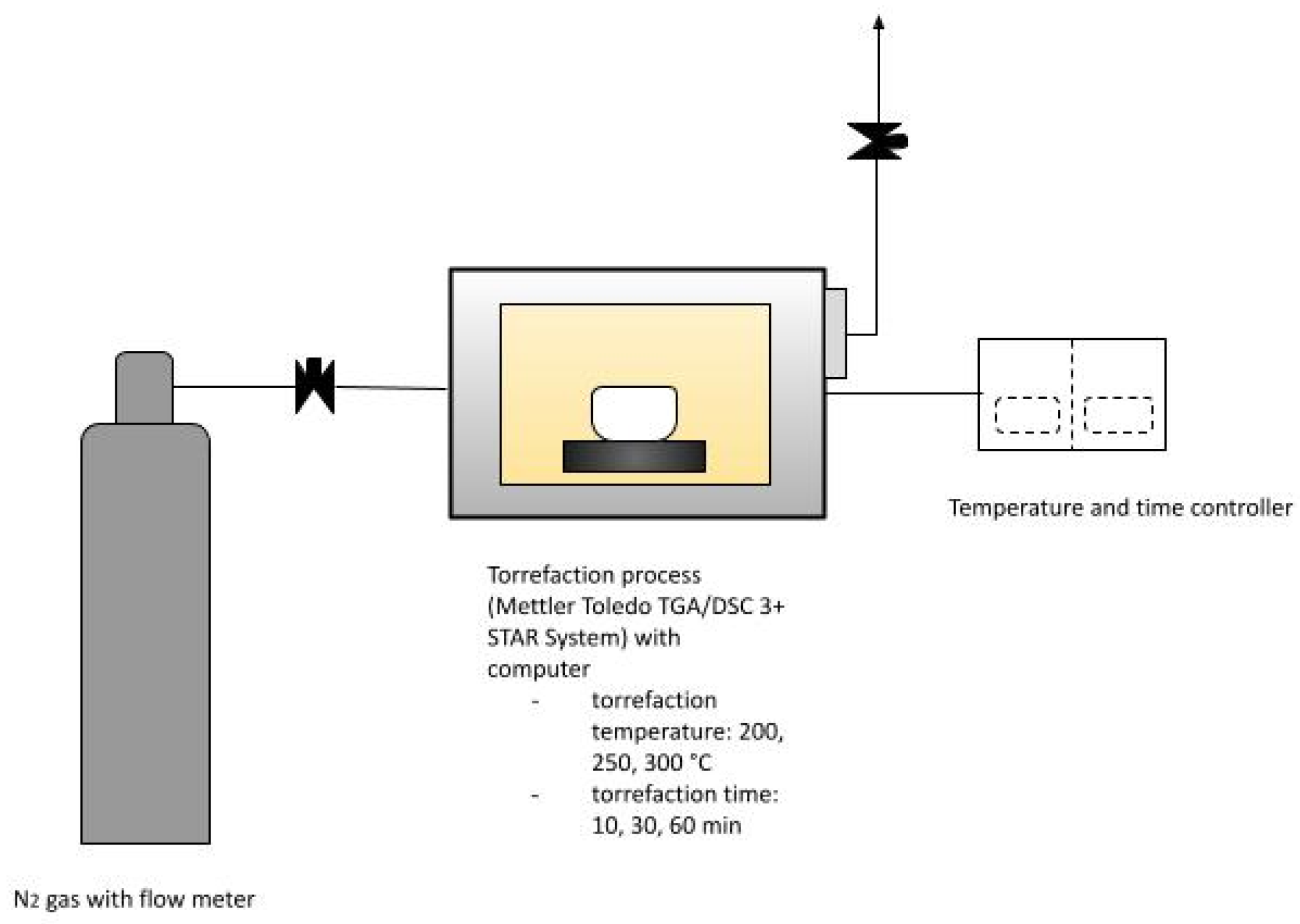
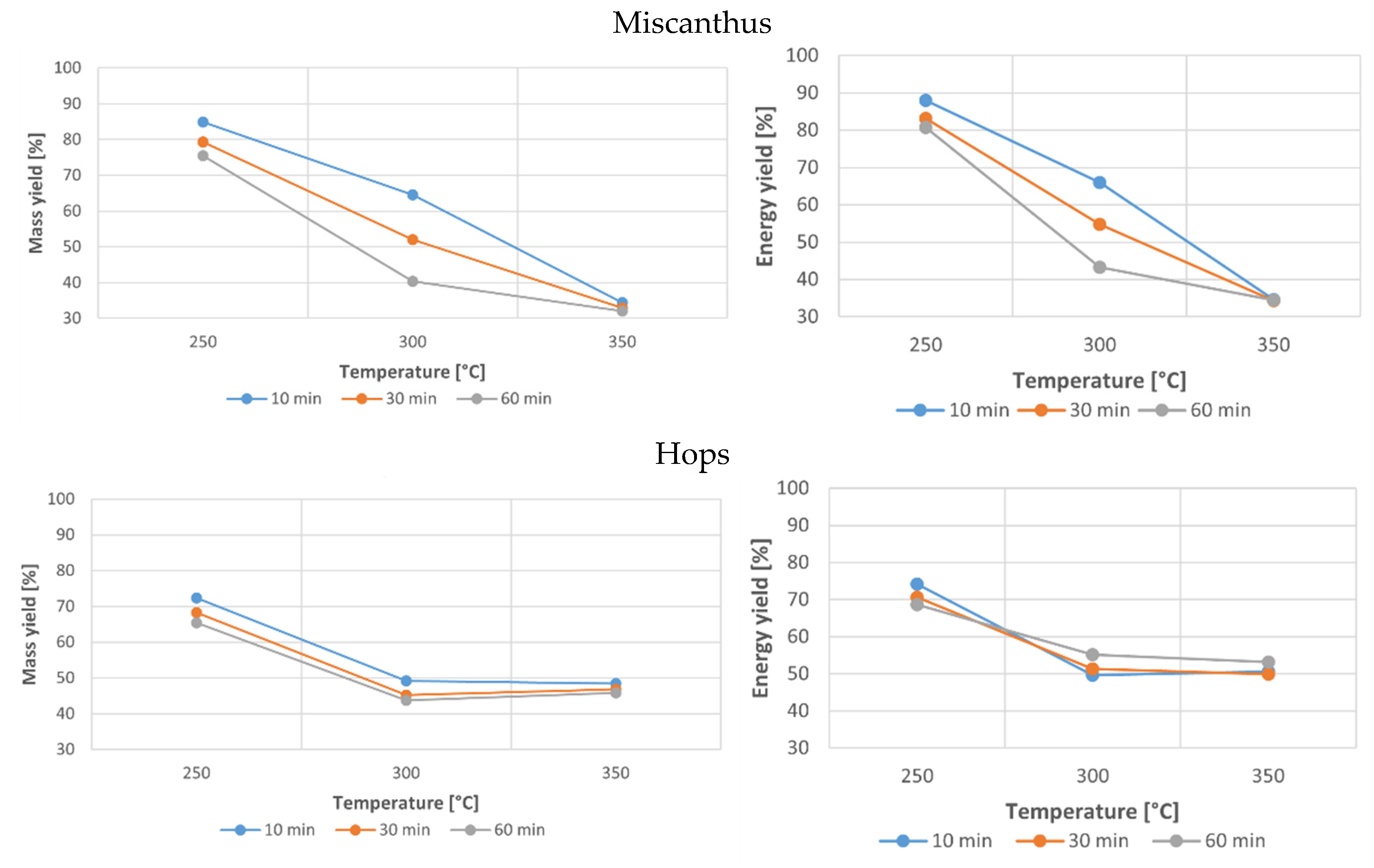



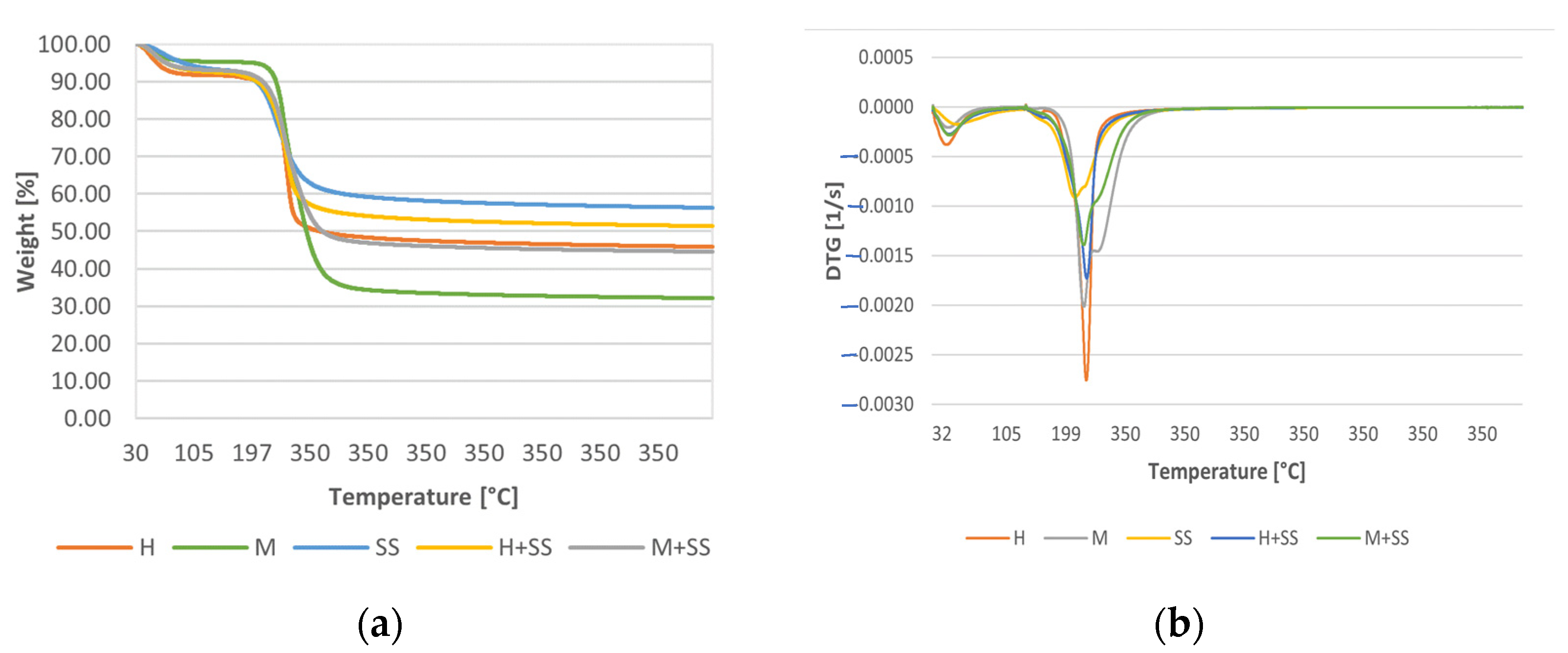

| Feedstock | Temperature (°C) | Duration (Time, min) | Main Finding | Reference |
|---|---|---|---|---|
| Rubberwood, Gliricidia | 250, 275, 300 | 30, 45, 60 | Calculated EMCI of Rubberwood at 275 °C and 60 min or 300 °C and 45–60 min and Gliricidia at 300 °C and 60 min indicate favourable torrefaction conditions. | [62] |
| Oak waste wood, mixed waste wood, sewage sludge | 220, 240, 260, 280, 300, 320, 340, 400 | 30, 60, 90, 120 | From an energy point of view, the optimal torrefaction temperature is 260 °C, and the optimal torrefaction time is 80 min. When TSI increases, the greater the loss in biomass. | [40] |
| Eucalypthus grandis | 210, 230, 250, 270, 290 | 10, 25, 40, 55, 70 | The results were determined by five indexes (weight loss, EF, TS, TSI, and TSF). The obtained results were confirmed to be meaningful for guiding torrefaction operations and reactor design. | [60] |
| Coffee grounds, Chinese medicine residue, algae residue (Arthrospira plantesis), and Microalgae residue (Chlamydomonas sp. JSC4) | 200, 250, 275, 300 | 15, 30, 45, 60 | Torrefaction severity factor (TSF) can accurately correlate weight loss and torrefaction severity index when optimizing the time exponent. | [14] |
| Coffee grounds, Chinese medicine residue, algae residue (Arthrospira plantesis) | 200, 250, 275, 300 | 15, 30, 45, 60 | The results suggested that the quantities of the individual biomass can be predicted via the torrefaction severity index. | [47] |
| Microalgae residue (Chlamydomonas sp. JSC4) | 200, 250, 300 | 15, 30, 60 | The results indicate that the torrefaction process has a larger influence on the oxygen and hydrogen losses as a consequence of dehydration and devolatilization. | [64] |
| Almond shell, almonds | 230, 260, 290 | 60, 80, 100 | Condensate mass yields and GCV increased in value for higher torrefaction temperatures and longer times when torrefying raw almond shells into a high-energy, dense fuel source with low moisture contents. | [65] |
| Microalgae residues (Chlamydomonas sp. JSC4 and Chlorella sorokiniana CY1) | 200, 225, 250, 275, 300 | 40, 60 | The calculated TSI of the two residues are similar to each other; therefore, this parameter may be used to describe the torrefaction extents of various biomass materials. | [63] |
| Biomass | (M) Miscanthus (100%) | (H) Hops (100%) | (SS) Sewage Sludge (100%) |
|---|---|---|---|
| Photos | 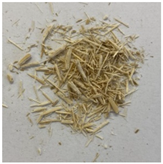 | 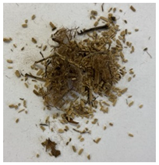 | 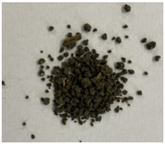 |
| Analysis | M | H | SS | M + SS | H + SS | |
|---|---|---|---|---|---|---|
| Proximate analysis (wt.%, dry basis) | Fixed carbon | 3.89 ± 0.08 | 2.01 ± 0.04 | 15.08 ± 0.30 | 7.41 ± 0.15 | 7.14 ± 0.14 |
| Volatile matter | 82.79 ± 3.31 | 82.23 ± 0.33 | 56.01 ± 2.24 | 67.89 ± 2.72 | 62.13 ± 2.49 | |
| Ash content | 2.83 ± 0.17 | 3.18 ± 0.19 | 16.33 ± 0.98 | 11.73 ± 0.70 | 13.48 ± 0.80 | |
| Moisture content (wt.%, dry basis) | 9.21 ± 0.27 | 11.01 ± 0.33 | 12.35 ± 0.37 | 10.34 ± 0.31 | 11.42 ± 0.34 | |
| Elemental analysis (wt.%, dry basis) | C | 45.11 ± 1.35 | 42.12 ± 1.27 | 34.67 ± 1.04 | 40.39 ± 1.21 | 38.98 ± 1.17 |
| H | 3.71 ± 0.11 | 4.54 ± 0.14 | 5.19 ± 0.15 | 4.67 ± 0.14 | 5.08 ± 0.15 | |
| N | 0.80 ± 0.02 | 3.49 ± 0.10 | 4.79 ± 0.14 | 3.94 ± 0.12 | 3.72 ± 0.11 | |
| O | 46.13 ± 1.38 | 47.43 ± 1.42 | 38.20 ± 1.15 | 36.33 ± 1.09 | 38.27 ± 1.15 | |
| S | 0.05 ± 0.01 | 0.03 ± 0.01 | 0.82 ± 0.04 | 0.31 ± 0.01 | 0.47 ± 0.01 | |
| Energy content (wt.%, dry basis) | HHV (MJ/kg) | 18.91 ± 0.95 | 16.56 ± 0.82 | 15.21 ± 0.76 | 17.04 ± 0.85 | 15.48 ± 0.77 |
| Material | T (°C) | HHV (MJ/kg) | EF | EMCI | ||||||
|---|---|---|---|---|---|---|---|---|---|---|
| 10 min | 30 min | 60 min | 10 min | 30 min | 60 min | 10 min | 30 min | 60 min | ||
| M | 250 | 19.59 | 19.80 | 20.26 | 1.04 | 1.05 | 1.07 | 3.05 | 3.73 | 5.38 |
| 300 | 19.34 | 19.94 | 20.3 | 1.02 | 1.05 | 1.07 | 1.47 | 2.83 | 2.97 | |
| 350 | 19.00 | 19.7 | 20.32 | 1.00 | 1.04 | 1.07 | 0.163 | 1.37 | 2.39 | |
| H | 250 | 16.98 | 17.12 | 17.38 | 1.03 | 1.03 | 1.05 | 1.84 | 2.31 | 3.24 |
| 300 | 16.71 | 18.78 | 20.9 | 1.01 | 1.13 | 1.26 | 0.45 | 6.06 | 10.45 | |
| 350 | 17.33 | 17.65 | 19.18 | 1.05 | 1.07 | 1.16 | 2.25 | 3.08 | 8.45 | |
| SS | 250 | 15.96 | 15.97 | 16.11 | 1.05 | 1.05 | 1.06 | 4.17 | 4.07 | 4.67 |
| 300 | 15.77 | 17.33 | 18.86 | 1.04 | 1.14 | 1.24 | 2.41 | 8.67 | 14.46 | |
| 350 | 15.46 | 16.11 | 16.79 | 1.02 | 1.06 | 1.10 | 0.97 | 3.39 | 5.85 | |
| M + SS | 250 | 17.91 | 17.81 | 18.01 | 1.05 | 1.05 | 1.06 | 4.33 | 3.68 | 4.43 |
| 300 | 17.43 | 17.92 | 18.53 | 1.02 | 1.05 | 1.09 | 1.55 | 3.09 | 4.71 | |
| 350 | 17.29 | 17.12 | 18.32 | 1.01 | 1.05 | 1.08 | 0.69 | 0.21 | 3.35 | |
| H + SS | 250 | 15.78 | 15.42 | 15.96 | 1.02 | 1.00 | 1.03 | 1.62 | 3.28 | 2.42 |
| 300 | 16.36 | 16.87 | 17.90 | 1.06 | 1.09 | 1.16 | 3.66 | 5.48 | 9.28 | |
| 350 | 15.29 | 15.10 | 15.36 | 1.00 | 1.00 | 1.00 | 0.66 | 1.28 | 0.39 | |
Publisher’s Note: MDPI stays neutral with regard to jurisdictional claims in published maps and institutional affiliations. |
© 2022 by the authors. Licensee MDPI, Basel, Switzerland. This article is an open access article distributed under the terms and conditions of the Creative Commons Attribution (CC BY) license (https://creativecommons.org/licenses/by/4.0/).
Share and Cite
Ivanovski, M.; Urbancl, D.; Petrovič, A.; Stergar, J.; Goričanec, D.; Simonič, M. Improving Lignocellulosic and Non-Lignocellulosic Biomass Characteristics through Torrefaction Process. Appl. Sci. 2022, 12, 12210. https://doi.org/10.3390/app122312210
Ivanovski M, Urbancl D, Petrovič A, Stergar J, Goričanec D, Simonič M. Improving Lignocellulosic and Non-Lignocellulosic Biomass Characteristics through Torrefaction Process. Applied Sciences. 2022; 12(23):12210. https://doi.org/10.3390/app122312210
Chicago/Turabian StyleIvanovski, Maja, Danijela Urbancl, Aleksandra Petrovič, Janja Stergar, Darko Goričanec, and Marjana Simonič. 2022. "Improving Lignocellulosic and Non-Lignocellulosic Biomass Characteristics through Torrefaction Process" Applied Sciences 12, no. 23: 12210. https://doi.org/10.3390/app122312210
APA StyleIvanovski, M., Urbancl, D., Petrovič, A., Stergar, J., Goričanec, D., & Simonič, M. (2022). Improving Lignocellulosic and Non-Lignocellulosic Biomass Characteristics through Torrefaction Process. Applied Sciences, 12(23), 12210. https://doi.org/10.3390/app122312210







